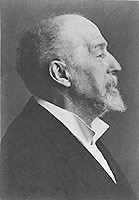Otto Wagner
Otto Wagner | |
|---|---|
 | |
| Born | July 13, 1841 |
| Died | April 11, 1918 (aged 76) |
| Nationality | Austria-Hungarian |
| Occupation | Architect |
| Parent(s) | Suzanne von Helffenstorffer-Hueber, Rudolf Simeon Wagner |
| Buildings | Floodgate, Nußdorf, Vienna Karlsplatz Stadtbahn Station
Rumbach Synagogue |
| Projects | Viennese Wiener Stadtbahn |
Otto Koloman Wagner (13 July 1841 – 11 April 1918) was an Austrian architect and urban planner. He influenced the development of his hometown Vienna at the turn from the 19th to the 20th century. He also was the architect of important landmarks.
Life[change | change source]
Otto Wagner was born in the Penzing district of Vienna. He studied in Berlin and Vienna. After work as brick layer he started as architect. His first buildings were in the historism style. In the late 1880s he became a proponent of the realism style. In 1890 he designed a city plan for Vienna but only the railway netwerk Wiener Stadtbahn was built. In 1894 he became Professor of Architecture at the Academy of Fine Arts Vienna.In 1896 he published a textbook entitled Modern Architecture in which he wrote down his ideas about the role of the architect, it based on his first lecture in the Academy. He called for an architecture based on modern materials and modern construction methods. In 1897, he joined Gustav Klimt, Joseph Maria Olbrich, Josef Hoffmann and Koloman Moser shortly after they founded the "Vienna Secession" artistic group. He died in 1918 in Vienna.
Works of Otto Wagner[change | change source]
-
Otto Wagner Villa
-
Anker-Haus, Wien;Am Graben
-
Railway station; Karlsplatz
-
Postal Office Savings Bank Building
-
Kirche Am Steinhof
-
Kirche Am Steinhof interior
Other websites[change | change source]
- Otto Wagner Museum in Vienna Archived 2007-02-27 at the Wayback Machine
- Great Buildings Online
- Images of several Wagner buildings
- Otto Wagner at WOKA (de/en) Archived 2004-06-04 at the Wayback Machine
- Majolica House in Vienna by Otto Wagner Archived 2007-09-30 at the Wayback Machine (with drawings and photos)
- AEIOU - Das österreichische Kulturinformationssystem
Digitized books from the architecture collection of AMS Historica, the digital library of the University of Bologna.
- (in German) Einige skizzen 1, Wien, 1905.
- (in German) Einige skizzen 2, Wien, 1905.
- (in German) Einige skizzen 3, Wien, 1905.






